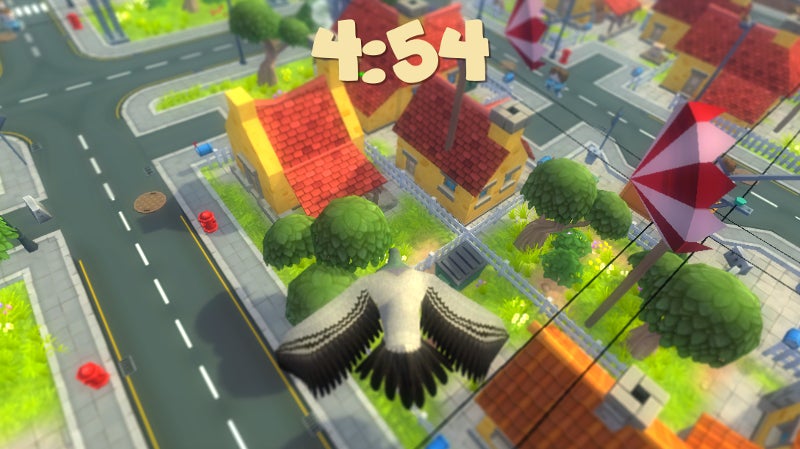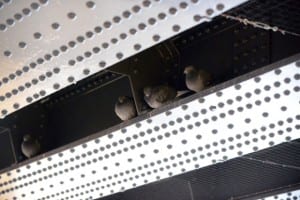
by Pigeon Patrol | Feb 1, 2016 | Bird Netting, Pigeon Patrol's Services, Pigeons in the News, UltraSonic Bird Control
Wonky Pigeon Sure Is A Game About A Pigeon That Poos On People
I mean, I’m not really sure what else I was expecting. Let me set the scene for you: I had just finished taking a ClickHole quiz entitled “Can You Match The Pigeons To The Way They’re Ruining My Whole Life?” Afterward, I stepped away from my PC to go down to the building that houses my apartment complex’s washing machine, to put my laundry in the drier. Boom: from behind a rubbish bin emerged a pigeon, eyes afire with some sort of bird emotion (probably vengeance) screaming into the sky.
“OK,” I thought to myself, “that was a little weird.”
Rattled, I returned to my PC to engage in one of my favourite self-care/loathing acts: checking Steam’s new releases page. Of course, my eyes immediately gravitated to Wonky Pigeon. It is highly unlikely that any of these events are connected, but there’s your idea for a modern reboot of Alfred Hitchcock’s The Birds, Hollywood.
So the game is about a pigeon trying to destroy cities with poop. Humanity played some kind of cruel joke on the pigeon, and then things got wacky. Also, apocalyptic.
But the rabbit — pigeon? — pigeon hole (ew) runs deeper. Look at this list of things that are in the game:
- Both evil and comic game story — Use a pigeon to destroy a city with poo.
- Beautiful cartoon graphics — You will love to shoot green poo.
- Split screen coop mode — Two pigeons is better than one.
- The dramatic poo cam — Drive the poo until it hits the target.
- Pigeon sounds by John J. Dick — The famous actor who voiced Serious Sam.
That last one took me by surprise too. I guess he does a mad solid pigeon impersonation? Stock recordings of pigeons also do a pretty good pigeon impersonation, but to each their own!
Anyway, Wonky Pigeon is a game about a pigeon who poos on people. That is pretty much The Whole Thing. It just launched on Steam Early Access, although curiously, I am unable to purchase it at the moment. So yes, the world is weird, and pigeons are arseholes (with other miscellaneous bird parts attached).
About Pigeon Patrol:
Pigeon Patrol Products & Services is the leading manufacturer and distributor of bird deterrent (control) products in Canada. Pigeon Patrol products have solved pest bird problems in industrial, commercial, and residential settings since 2000, by using safe and humane bird deterrents with only bird and animal friendly solutions. At Pigeon Patrol, we manufacture and offer a variety of bird deterrents, ranging from Ultra-flex Bird Spikes with UV protection, Bird Netting, 4-S Gel and the best Ultrasonic and audible sound devices on the market today.
Voted Best Canadian wholesaler for Bird Deterrent products four years in a row.
Contact Info: 1- 877– 4– NO-BIRD (www.pigeonpatrol.ca)

by Pigeon Patrol | Jan 31, 2016 | 4-S Gel Bird repellent, Bird Netting, Pigeon Patrol's Services, UltraSonic Bird Control
 I was sitting in the High Street, outside M & S, waiting for Sue to finish buying up the whole store.
I was sitting in the High Street, outside M & S, waiting for Sue to finish buying up the whole store.
A chap came up and had a carrier bag of tit-bits for the pigeons.
They seemed to know him and flew down for a bit of lunch.
How healthy they looked with most of them still having their legs and toes.
In London practically all the pigeons look tatty, have no feet or are dragging a leg because it was entwined with cotton, wire or some other form of ligature.
Previously I had been sitting, waiting for the train, on Marylebone Station.
A couple of pigeons were gleaning what they could on the concourse.
There it was.
One had a definite limp with cotton wrapped around its leg, a ligature almost severing the foot.
How could I ignore it?
I couldn’t.
I went into M & S and bought some biscuits.
The plan was to entice our pigeon to come within distance then I could pounce and grab.
Did this without any trouble. Then to untangle the cotton from its leg.
Bad mistake.
As I started to unwind it the leg started to bleed profusely.
From being a hero I had become a villain who made pigeons bleed.
I stemmed the bleeding with tissues and getting a box, once more in M & S, I took my bemused pigeon back to Tiggys where, once the cotton had been removed, the leg could be sutured back together.
The true endorsement of the pigeon that I witnessed was in St Mark’s Square in Venice.
The local council had banned the sale of pigeon food. I was in Venice where a group of tourists in wheelchairs were having a fabulous time feeding the pigeons. They were loving every minute of it.
Leave the pigeons be.
Somebody loves them.
About Pigeon Patrol:
Pigeon Patrol Products & Services is the leading manufacturer and distributor of bird deterrent (control) products in Canada. Pigeon Patrol products have solved pest bird problems in industrial, commercial, and residential settings since 2000, by using safe and humane bird deterrents with only bird and animal friendly solutions. At Pigeon Patrol, we manufacture and offer a variety of bird deterrents, ranging from Ultra-flex Bird Spikes with UV protection, Bird Netting, 4-S Gel and the best Ultrasonic and audible sound devices on the market today.
Voted Best Canadian wholesaler for Bird Deterrent products four years in a row.
Contact Info: 1- 877– 4– NO-BIRD (www.pigeonpatrol.ca)

by Pigeon Patrol | Jan 30, 2016 | Bird Netting, Pigeon Patrol's Services, Pigeon Spikes, UltraSonic Bird Control
 Rick Gibson, UA Cooperative Extension
Rick Gibson, UA Cooperative Extension
Birds can devastate young vegetable seedlings or ruin fresh fruit in the blink of an eye but if we know what to do, and take action before they strike, we can often prevent problems.
Many of us are all too familiar with damage caused by birds to ripening apricots, plums, grapes and other garden fruits. We know it happens and even come to expect it. However, few people realize that birds can also seriously damage vegetable gardens. The fact is that yes, birds can make pests of themselves in vegetable gardens, particularly when young plants are in the seedling stage. Some people would be quick to say that they can be very aggravating pests. For those who know what I am talking about, I sense your frustration.
Birds can damage fruit and vegetables in two basic ways. The most obvious is direct feeding and the other is contamination of food products. Let’s consider some examples.
Horned larks are notorious in the commercial vegetable industry and in home vegetable gardens for nipping at new seedlings emerging from the ground. They usually don’t really eat the plant. Mostly they just bite it, perhaps for a taste of the sap. Sometimes though, they will pull it completely out of the ground. In these cases, it is not uncommon to find the poor, abused seedling lying discarded nearby after this not too gentle treatment. Horned larks are not the only ones that do this of course, but they are notorious for this kind of damage.
Other birds like finches, sparrows, thrashers and wrens will peck holes in the soft flesh of ripening fruit. Figs, apricots, peaches and plums are common targets for birds. Woodpeckers and their relatives, the sapsuckers, peck holes in the rinds of citrus fruit looking for a juicy taste of fresh fruit. Many birds figure out how to hunt the seeds that you just put in the ground and have lunch at your expense. If you are growing your own grains, watch out for the red-winged blackbird. They and their cronies will absolutely love your harvest.
Birds also cause damage to garden crops through direct contamination of the edible parts of the plant. Bird droppings are usually not a problem when they fall on fruits that will be peeled, but when they end up on difficult to wash fruit like blackberries, strawberries and clusters of table grapes, they make a real mess and the residues could harbor disease.
The sight of bird feces on fresh fruit is guaranteed to quickly destroy any desire one might have to pluck a ripe fruit and plop it directly in the mouth. Even so, most produce can be cleansed with a careful washing. In fact, it is a good idea to inspect food materials carefully before you place anything in your mouth. Even if you can’t see any contamination, it is always good to wash before you eat. It is better to be safe than sorry, I say.
How do we prevent bird problems in the garden? When thinking about control, many people quickly jump to the idea of chemical poisons and repellents. However, since most gardeners do not have the proper training, certification and license to use chemicals to control birds, that way is out. Don’t even think about it. Put it out of your mind. Don’t go there.
The same goes for shooting with fire arms, sling shots or arrows. There are a whole bunch of laws that if violated, could bring embarrassment, financial difficulties and even imprisonment. Unless you have legal permission, birds cannot be harmed in any way. Just so we are clear, almost every bird you see is protected by state and/or federal regulations. Killing or injuring birds without a license carries a stiff punishment and could get you into big trouble. Don’t do it.
So, what can you do to protect your garden from the ravages of hungry birds? There are a number of things that can be done and most fall within three categories: frightening devices, mechanical barriers and habitat modification.
Okay, let me emphasize right here that I am not recommending the use of loud sounds in populated areas to frighten away birds. While farmers out in the country might get away with propane cannons, fireworks and blank shotgun blasts, no one in the city wants to wake up to a loud bang or pop at the crack of dawn. Not only will the neighbors be upset, but the local law enforcement community also. They take a dim view of such activities, even if it is in the name of good gardening, because there are laws against disturbing the public peace.
On the other hand, a good predator silhouette works very well to frighten birds away. It is quiet and causes no harm to the animals. Some people use hawks or snakes, but I like to use an owl. Strategically placed and moved regularly, birds have a tough time telling the difference between a real owl and a plastic one in the few seconds they have to make a life or death decision. I really like the plastic owl that, with power from a solar collector, is able to move its head. Any movement is good because it gives the birds a more realistic view. I have seen birds literally do a U-turn in mid flight when they suddenly see what they think is a live owl hiding among the foliage of a fig or apricot fig. Predator images seem to work equally well in vegetable gardens.
Mechanical barriers are another good way to keep birds away from sensitive plants. Many people already use bird netting over citrus, apricots, grapes and plums to protect their fruit. Floating row covers, light spun fabric especially designed for agricultural use or the netting you use on your fruit trees can be set up to keep birds away from tender vegetable plants until they are large enough that birds lose interest. The floating row cover can be laid directly on top of the plants because they are light enough that they do not damage plants. Netting can be laid on top of a pole framework to keep them off the plants.
The last way to prevent bird damage is to change the natural habitat around your garden. Modifying conditions to make the area less interesting to the birds will help prevent bird populations from becoming excessive. The fewer the birds, the less damage will be sustained.
Of course, birds can travel some distance to a feeding area so habitat modification may have its limits, but anytime we can camouflage or make a feeding site less interesting, the better off we will be. Common modification techniques include removing roosting areas like trees and shrubs in the vicinity of the garden area, moving the bird bath and decorative bird houses to another part of the yard and eliminating nearby resting areas.
Birds cause many types of damage in the garden. While there are some things that we definitely should not do, there are steps that you and I can take to effectively prevent bird damage without harming protected species.
About Pigeon Patrol:
Pigeon Patrol Products & Services is the leading manufacturer and distributor of bird deterrent (control) products in Canada. Pigeon Patrol products have solved pest bird problems in industrial, commercial, and residential settings since 2000, by using safe and humane bird deterrents with only bird and animal friendly solutions. At Pigeon Patrol, we manufacture and offer a variety of bird deterrents, ranging from Ultra-flex Bird Spikes with UV protection, Bird Netting, 4-S Gel and the best Ultrasonic and audible sound devices on the market today.
Voted Best Canadian wholesaler for Bird Deterrent products four years in a row.
Contact Info: 1- 877– 4– NO-BIRD (www.pigeonpatrol.ca)

by Pigeon Patrol | Jan 29, 2016 | Bird Netting, Pigeon Spikes, Pigeons in the News, UltraSonic Bird Control
 They may only have a brain the size of a thimble, but it appears pigeons can categorise and name objects in the same way a human children learn new words.
They may only have a brain the size of a thimble, but it appears pigeons can categorise and name objects in the same way a human children learn new words.
A new study from the University of Iowa has shown that the birds are capable of learning to categorise 128 different photographs into 16 basic categories.
Scientists taught three pigeons to attribute different breeds of dog or types of shoe, for example to a particular symbol in exchange for a reward.
CROWS ARE PROBLEM SOLVERS
Crows are widely thought to be among the most intelligent of birds, but a recent study found they are even smarter than first thought, capable of solving complex tasks previously thought possible only by humans, apes and monkeys.
Most impressively, they performed the tasks spontaneously – without any prior training.
Two hooded crows were placed into a wire mesh cage into which a plastic tray containing three small cups was occasionally inserted.
The sample cup in the middle was covered with a small card that had a colour, shape or number of items pictured on it.
The other two cups were also covered with cards – one that matched the sample, and one that didn’t.
The cup under the matching card contained mealworms, which the crows were rewarded with if they chose the correct match.
The crows were then required to conduct a similar task but with images on cards that did not precisely match.
Researchers were surprised that the not only could the crows correctly perform these relational matches, with a success rate of 78 per cent – 50 per cent being regarded as chance – but that they did so spontaneously, without explicit training.
However, the researchers said it took their birds around 40 days to perfect the task of learning just 16 categories.
Professor Edward Wasserman, a psychologist at the University of Iowa who led the work, said: ‘Our birds’ rate of learning appears to have been quite slow. Human adults regularly learn 16 categories in the space of an hour, yet, pigeons took 45,000 trials to reach their associative limits.
‘Would children learn faster than pigeons? Almost certainly. However, our pigeons came to the experiment with literally no background knowledge.
‘They did not understand the nature of the “task”, they had not encountered these categories before, and they had empty lexicons.
‘Children, on the other hand, bring all of these things to bear on the problem of learning words.
‘Thus, the more relevant comparison group may be newborn infants, who indeed take 6–9 months to learn their first words.’
On each training day, the researchers presented each of the pigeons with 128 randomly ordered images.
Each image fitted into one of 16 categories – baby, bottle, cake, car, cracker, dog, duck, fish, flower, hat, key, pen, phone, plan, shoe, tree.
The birds then had to peck on one of two different colour symbols presented to them on a touchscreen computer – one that was associated with the correct category and the other the wrong category.
If the birds selected the correct symbol they were rewarded with a pellet of food. Incorrect choices plunged the birds into darkness foir a new seconds.
After the training, the birds were then presented with images from the categories they had not seen before to see if they could correctly attribute them.
Pigeons are known for their ability to find their way home, but the new study suggests they are even smarter
One of the birds reached an accuracy of 80 per cent, a second achieved 70 per cent accuracy and the third was 65 per cent accurate.
Writing in the journal Cognition, the researchers said their experiment was a very simple mirror of the way children are taught words – by their parents pointing to pictures and asking them to name the object.
They said: ‘Our paradigm is not a direct analog of human word learning.
‘Nevertheless, it does offer a unique biological model of a critical property of word learning – namely, the fact that a learner must map many exemplars to many categories.’
Professor Wasserman added: ‘Unlike prior attempts to teach words to primates, dogs, and parrots, we used neither elaborate shaping methods nor social cues.
‘Our pigeons were trained on all 16 categories simultaneously, a much closer analog of how children learn words and categories.
‘Differences between humans and animals must indeed exist – many are already known – but, they may be outnumbered by similarities.
‘Our research on categorization in pigeons suggests that those similarities may even extend to how children learn words.’
The scientists taught the pigeons to group images of real objects into the 16 distinct categories shown above
Pigeons are known to be smarter than many birds and their homing instinct allows them to memorise their location and find their way home from hundreds of miles away.
Professor Bob McMurray, another psychologist who took part in the study, said the results showed that human learning is not as unique as was previously believed.
He said: ‘Children are confronted with an immense task of learning thousands of words without a lot of background knowledge to go on.
‘For a long time, people thought that such learning is special to humans.
‘What this research shows is that the mechanisms by which children solve this huge problem may be mechanisms that are shared with many species.’
CROWS ARE ‘LEFT-BEAKED’ OR ‘RIGHT-BEAKED’
Researchers studying New Caledonian crows recently discovered the clever corvids display a preference for holding a stick tool on a certain side of their beaks – and this could be to make the most of their wide field of vision.
The researchers believe the birds may be trying to keep the tip of the stick in view of the eye on the opposite side of their heads, so they can see clearly in order to use tools in the most dexterous way.
Lead scientist Dr Alejandro Kacelnik, from Oxford University, said: ‘If you were holding a brush in your mouth and one of your eyes was better than the other at brush length, you would hold the brush so that its tip fell in view of the better eye. This is what the crows do.’
New Caledonian crows surprised experts with their ability to use sticks to extract larvae from burrows and, in captivity, retrieve food placed out of reach.
The study, published in the journal Current Biology, also suggests that the birds’ unusually wide field of vision actually helps them to see better with one eye.
About Pigeon Patrol:
Pigeon Patrol Products & Services is the leading manufacturer and distributor of bird deterrent (control) products in Canada. Pigeon Patrol products have solved pest bird problems in industrial, commercial, and residential settings since 2000, by using safe and humane bird deterrents with only bird and animal friendly solutions. At Pigeon Patrol, we manufacture and offer a variety of bird deterrents, ranging from Ultra-flex Bird Spikes with UV protection, Bird Netting, 4-S Gel and the best Ultrasonic and audible sound devices on the market today.
Voted Best Canadian wholesaler for Bird Deterrent products four years in a row.
Contact Info: 1- 877– 4– NO-BIRD (www.pigeonpatrol.ca)

by Pigeon Patrol | Jan 21, 2016 | Bird Netting, Pigeons in the News, UltraSonic Bird Control
 After years of war with the pigeons, Venice is now in war with the seagulls. The birds have become very aggressive. At one point last summer they’ve attacked a man working on a rooftop. Recently, the seagulls have become so brave that they jump on trays carried by the waiters in Piazza San Marco. They even hunt and kill pigeons for food. The point is, the new treat on the main Piazza in Venice comes from the seagulls who are no longer scared from humans and do not fear our reaction against them.
After years of war with the pigeons, Venice is now in war with the seagulls. The birds have become very aggressive. At one point last summer they’ve attacked a man working on a rooftop. Recently, the seagulls have become so brave that they jump on trays carried by the waiters in Piazza San Marco. They even hunt and kill pigeons for food. The point is, the new treat on the main Piazza in Venice comes from the seagulls who are no longer scared from humans and do not fear our reaction against them.
The numbers of pigeons in Venice have fallen sharply when a few years ago the city banned the sale of grains. However, seagulls are the new phenomenon that is gradually becoming even worse then the pigeons. You can see them early in the morning roaming around the trashcans, opening bags of garbage and eating leftovers, before the sweepers are able to pick them up.
gabbiani e colombi ai tavolini del caffe florianNow with the arrival of spring, the eggs hatch and with little to satisfy their hunger, the problem is getting greater. Finding a solution from the city, the region and the local health organization is urgently needed. Eighty nests have been found in the city since 2006 and their number has grown greatly since then. Now there are too many to be destroyed at once. “In Piazza San Marco which is a limited space you might think is the first place to begin the destruction – says Giuseppe Cherubini who is responsible for Hunting and Fishing of the Region – the nests are in the Basilica, in the Ducal Palace and the Magistrates, we are willing to give permission for their removal immediately.” The task however is not that easy. There has been even a proposal to introduce falcons or hawks that could naturally eliminate the great number of seagulls. However, an animal and birds expert, who asked to remain anonymous, said: “In Italy there are regulatory issues, the herring gull is a protected species.” According to other experts it is not easy to use hawks in a small space as the San Marco Square.
So, for now the problem will still stay unresolved in Venice. There is a new war between pigeons, seagulls and humans and so far the seagulls are winning. It seems that the easiest solution is to limit the food consumption on the Piazza San Marco to only designated areas and bars. Besides, who wants to walk around people who are using the square for a picnic site, spreading blankets and baskets with food?
About Pigeon Patrol:
Pigeon Patrol Products & Services is the leading manufacturer and distributor of bird deterrent (control) products in Canada. Pigeon Patrol products have solved pest bird problems in industrial, commercial, and residential settings since 2000, by using safe and humane bird deterrents with only bird and animal friendly solutions. At Pigeon Patrol, we manufacture and offer a variety of bird deterrents, ranging from Ultra-flex Bird Spikes with UV protection, Bird Netting, 4-S Gel and the best Ultrasonic and audible sound devices on the market today.
Voted Best Canadian wholesaler for Bird Deterrent products four years in a row.
Contact Info: 1- 877– 4– NO-BIRD (www.pigeonpatrol.ca)

by Pigeon Patrol | Jan 19, 2016 | Bird Netting, Pigeon Spikes, UltraSonic Bird Control
 SAN FRANCISCO (KCBS)— When most people think of pigeons, the common city street bird comes to mind, but there’s a different kind of pigeon in California and it’s at risk, according to environmental scientists.
SAN FRANCISCO (KCBS)— When most people think of pigeons, the common city street bird comes to mind, but there’s a different kind of pigeon in California and it’s at risk, according to environmental scientists.
Most of the Pacific Coast Band-tailed pigeons are dying specifically between San Francisco and San Diego. The stocky, reclusive bird is the state’s only native pigeon. Its head is a beautiful purple accompanied by a yellow bill and legs.
Environmental scientists at the California Department of Fish and Wildlife have identified a parasite as avian trichomoniasis, an organism that lives in the throat and mouth of the infected bird, which prohibits them from eating.
Dr. Jennifer Scarlett with the San Francisco SPCA said the street pigeon is thought to be the main source of infection for the bird.
“What happens is where there’s lots of birds congregating, especially around bird feeders and watering holes, is where we’ll see this transmit to the California native pigeon,” Scarlett said.
While there aren’t risks of transmission to other animals, the parasite can be transmitted to other birds such as raptors and hawks.
If you have a birdfeeder in your home’s yard, officials ask that you clean them or even to get rid of them for the next few months.
About Pigeon Patrol:
Pigeon Patrol Products & Services is the leading manufacturer and distributor of bird deterrent (control) products in Canada. Pigeon Patrol products have solved pest bird problems in industrial, commercial, and residential settings since 2000, by using safe and humane bird deterrents with only bird and animal friendly solutions. At Pigeon Patrol, we manufacture and offer a variety of bird deterrents, ranging from Ultra-flex Bird Spikes with UV protection, Bird Netting, 4-S Gel and the best Ultrasonic and audible sound devices on the market today.
Voted Best Canadian wholesaler for Bird Deterrent products four years in a row.
Contact Info: 1- 877– 4– NO-BIRD (www.pigeonpatrol.ca)




 I was sitting in the High Street, outside M & S, waiting for Sue to finish buying up the whole store.
I was sitting in the High Street, outside M & S, waiting for Sue to finish buying up the whole store.
 Rick Gibson, UA Cooperative Extension
Rick Gibson, UA Cooperative Extension
 They may only have a brain the size of a thimble, but it appears pigeons can categorise and name objects in the same way a human children learn new words.
They may only have a brain the size of a thimble, but it appears pigeons can categorise and name objects in the same way a human children learn new words.
 After years of war with the pigeons, Venice is now in war with the seagulls. The birds have become very aggressive. At one point last summer they’ve attacked a man working on a rooftop. Recently, the seagulls have become so brave that they jump on trays carried by the waiters in Piazza San Marco. They even hunt and kill pigeons for food. The point is, the new treat on the main Piazza in Venice comes from the seagulls who are no longer scared from humans and do not fear our reaction against them.
After years of war with the pigeons, Venice is now in war with the seagulls. The birds have become very aggressive. At one point last summer they’ve attacked a man working on a rooftop. Recently, the seagulls have become so brave that they jump on trays carried by the waiters in Piazza San Marco. They even hunt and kill pigeons for food. The point is, the new treat on the main Piazza in Venice comes from the seagulls who are no longer scared from humans and do not fear our reaction against them.
 SAN FRANCISCO (KCBS)— When most people think of pigeons, the common city street bird comes to mind, but there’s a different kind of pigeon in California and it’s at risk, according to environmental scientists.
SAN FRANCISCO (KCBS)— When most people think of pigeons, the common city street bird comes to mind, but there’s a different kind of pigeon in California and it’s at risk, according to environmental scientists.